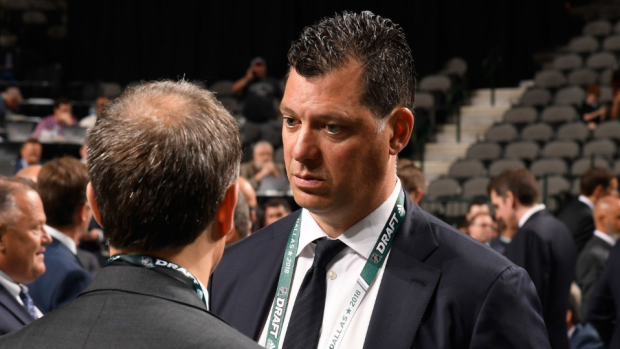Aug 22, 2019
New Wild GM Guerin facing uphill battle in Minnesota
Long-term, new Minnesota Wild GM Bill Guerin is facing quite the uphill battle. Prior regimes saddled Guerin with something of a salary cap disaster, flush with expensive long-term contracts and little immediately available help in the prospect pool with an aging roster, Travis Yost writes.
By Travis Yost

On Wednesday, the Minnesota Wild announced four-time Stanley Cup champion Bill Guerin as their new general manager.
There is cautious optimism surrounding the hire. The team still has one of the best head coaches in all of hockey in Bruce Boudreau, who will oversee a roster that still has enough talent around to remain competitive in 2019-20. And, quite frankly, it’s hard to imagine him doing a worse job than his predecessor.
That is the short-term, though. Long-term, Guerin is facing quite the uphill battle. Prior regimes saddled Guerin with something of a salary cap disaster, flush with expensive long-term contracts and little immediately available help in the prospect pool. And the biggest concern may be the fact that the shelf life on the current roster is already reaching expiry.
One of the first questions Guerin will have to answer in reshaping the organization is how to get younger. Heading into the 2019-20 season, the average NHL roster sits at just under 27 years of age. Initially, most teams would concentrate on a youth movement within the forward groups, but that has also manifested on the blueline in recent years. There are two obvious reasons for this: younger players tend to have a more positive impact on team performance than the rest of the playing class, and thanks to the NHL’s Collective Bargaining Agreement and contract restrictions, they tend to be more financially friendly.
Consider some of Minnesota’s core players for just a moment. Team captain Mikko Koivu, entering the final year of his deal, is 36. Zach Parise (35) is signed for another six seasons. Eric Staal (34) still has two more years on his deal. The team’s biggest free agent signing this summer was 31-year-old Mats Zuccarello on a five-year deal. On the blueline, their first pairing anchor in Ryan Suter (34) has six years left on his contract. Their starting goaltender? A 33-year-old Devan Dubnyk.
You get the point. Some of these players are still reliable. But in aggregate, Minnesota is in the untenable position of having little cap flexibility on a base of one of the oldest rosters in the entire league.
Minnesota having an aged lineup is one thing, and that roster carrying some pretty substantial long-term contracts obviously compounds the issue. However, there is a third wrinkle that Guerin will have to work through, and that’s how to displace the significant workload the majority of these veteran players are currently shouldering.
I mentioned earlier that some of these skaters are still effective, and it’s true – guys like Staal and Parise have been valuable contributors in recent years, and there is no reason to believe they will immediately crater in the following season. If Minnesota just had to work to displace their minutes as they entered a transition season, it wouldn’t be much of a problem.
But nearly half of the roster is sorely in need of some minutes reallocation. That really starts with Suter, who over the last two years has played more minutes than any skater not named Drew Doughty. Suter isn’t the only player who may be stretched a bit thin, though:
What I’ll be most interested to see is how aggressive Guerin is in stripping this roster down for an expected – if not inevitable – transitionary period. Again, I think this Wild team is talented enough to be competitive again next year, and I think having such a strong head coach lends itself to seeing what this lineup can do for another year.
But what if Minnesota struggles out of the gate, or Guerin’s appetite for a youth driven rebuild overwhelms his desire to try and push for a playoff spot this year? We could see a teardown start in relatively short order. And if that’s the case, there may be some interesting names shaking loose on the trade market before the Feb. 24, 2020 trade deadline.

